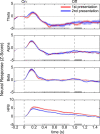Diverse Temporal Dynamics of Repetition Suppression Revealed by Intracranial Recordings in the Human Ventral Temporal Cortex
- PMID: 32583847
- PMCID: PMC7732032
- DOI: 10.1093/cercor/bhaa173
Diverse Temporal Dynamics of Repetition Suppression Revealed by Intracranial Recordings in the Human Ventral Temporal Cortex
Abstract
Repeated stimulus presentations commonly produce decreased neural responses-a phenomenon known as repetition suppression (RS) or adaptation-in ventral temporal cortex (VTC) of humans and nonhuman primates. However, the temporal features of RS in human VTC are not well understood. To fill this gap in knowledge, we utilized the precise spatial localization and high temporal resolution of electrocorticography (ECoG) from nine human subjects implanted with intracranial electrodes in the VTC. The subjects viewed nonrepeated and repeated images of faces with long-lagged intervals and many intervening stimuli between repeats. We report three main findings: 1) robust RS occurs in VTC for activity in high-frequency broadband (HFB), but not lower-frequency bands; 2) RS of the HFB signal is associated with lower peak magnitude (PM), lower total responses, and earlier peak responses; and 3) RS effects occur early within initial stages of stimulus processing and persist for the entire stimulus duration. We discuss these findings in the context of early and late components of visual perception, as well as theoretical models of repetition suppression.
Keywords: adaptation; electrocorticography; perception; repetition suppression; temporal dynamics.
© The Author(s) 2020. Published by Oxford University Press. All rights reserved. For permissions, please e-mail: journals.permissions@oup.com.
Figures







Similar articles
-
Corresponding ECoG and fMRI category-selective signals in human ventral temporal cortex.Neuropsychologia. 2016 Mar;83:14-28. doi: 10.1016/j.neuropsychologia.2015.07.024. Epub 2015 Jul 23. Neuropsychologia. 2016. PMID: 26212070 Free PMC article.
-
fMRI-adaptation and category selectivity in human ventral temporal cortex: regional differences across time scales.J Neurophysiol. 2010 Jun;103(6):3349-65. doi: 10.1152/jn.01108.2009. Epub 2010 Apr 7. J Neurophysiol. 2010. PMID: 20375251 Free PMC article.
-
Neural repetition suppression in ventral occipito-temporal cortex occurs during conscious and unconscious processing of frequent stimuli.Neuroimage. 2014 Jul 15;95:129-35. doi: 10.1016/j.neuroimage.2014.03.049. Epub 2014 Mar 22. Neuroimage. 2014. PMID: 24667455
-
Sources of adaptation of inferior temporal cortical responses.Cortex. 2016 Jul;80:185-95. doi: 10.1016/j.cortex.2015.08.024. Epub 2015 Sep 25. Cortex. 2016. PMID: 26518166 Review.
-
The functional architecture of the ventral temporal cortex and its role in categorization.Nat Rev Neurosci. 2014 Aug;15(8):536-48. doi: 10.1038/nrn3747. Epub 2014 Jun 25. Nat Rev Neurosci. 2014. PMID: 24962370 Free PMC article. Review.
Cited by
-
Temporally and functionally distinct large-scale brain network dynamics supporting task switching.Neuroimage. 2022 Jul 1;254:119126. doi: 10.1016/j.neuroimage.2022.119126. Epub 2022 Mar 22. Neuroimage. 2022. PMID: 35331870 Free PMC article.
-
Temporal dynamics of short-term neural adaptation across human visual cortex.PLoS Comput Biol. 2024 May 30;20(5):e1012161. doi: 10.1371/journal.pcbi.1012161. eCollection 2024 May. PLoS Comput Biol. 2024. PMID: 38815000 Free PMC article.
-
Automatic Sensory Predictions: A Review of Predictive Mechanisms in the Brain and Their Link to Conscious Processing.Front Hum Neurosci. 2021 Aug 18;15:702520. doi: 10.3389/fnhum.2021.702520. eCollection 2021. Front Hum Neurosci. 2021. PMID: 34489663 Free PMC article. Review.
-
A rapid theta network mechanism for flexible information encoding.Nat Commun. 2023 May 19;14(1):2872. doi: 10.1038/s41467-023-38574-7. Nat Commun. 2023. PMID: 37208373 Free PMC article.
-
Attenuation of High Gamma Activity by Repetitive Motor Tasks.Hum Brain Mapp. 2025 Feb 1;46(2):e70153. doi: 10.1002/hbm.70153. Hum Brain Mapp. 2025. PMID: 39918031 Free PMC article.
References
-
- Aarts E, Verhage M, Veenvliet JV, Dolan CV, van der Sluis S. 2014. A solution to dependency: using multilevel analysis to accommodate nested data. Nat Neurosci. 17:491–496. - PubMed
-
- Allison T, Puce A, Spencer DD, McCarthy G. 1999. Electrophysiological studies of human face perception. I: potentials generated in occipitotemporal cortex by face and non-face stimuli. Cereb Cortex. 9:415–430. - PubMed
-
- Benjamini Y, Drai D, Elmer G, Kafkafi N, Golani I. 2001. Controlling the false discovery rate in behavior genetics research. Behav Brain Res. 125:279–284. - PubMed
Publication types
MeSH terms
Grants and funding
LinkOut - more resources
Full Text Sources
Miscellaneous

